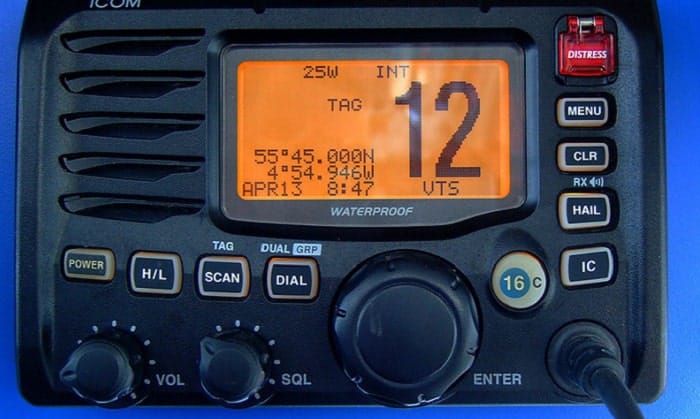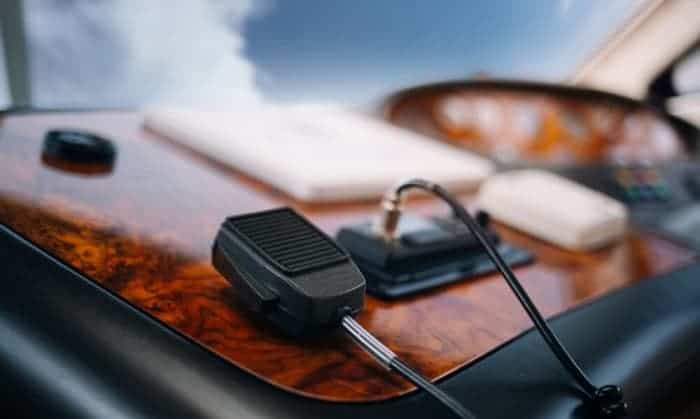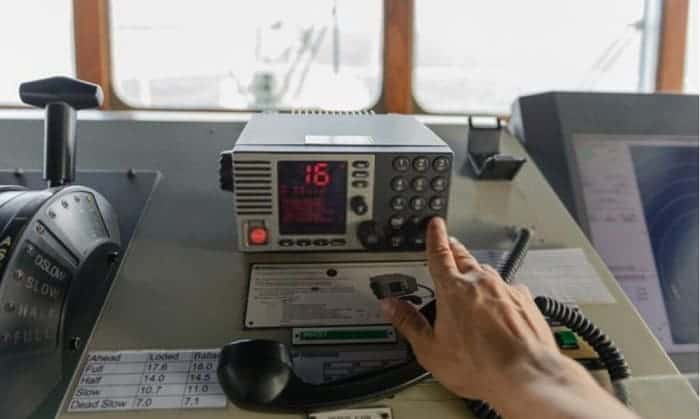While operating a VHF marine radio, when should the term ‘mayday’ be used? This concern should not be ignored as this is not a trivial thing. Channel 16 is used to make mayday calls. This channel is not for casual communication at all.
Mayday calls are made when life-threatening emergencies onboard happen. The word ‘mayday’ is repeated thrice, and then, you can describe your situation that needs immediate attention.
Mayday can be compared with 911 emergency services. Every boat owner should know when to make a call and come up with a comprehensive plan for the safety of everyone in a vessel.
For more, read until the end of this article answering when operating a VHF marine radio, when should the term mayday be used.
Table of Contents
Why It’s A Must To Have A VHF Marine Radio On Board
VHF Marine radios from Uniden, Standard Horizon, Icom, and Cobra are dependable. They are sought by boaters due to the following reasons:
- Function as easy-to-use lifesavers
- More effective than mobile phones and CB radios
- Has consistent reception compared to mobile phones
- License is not required when used in recreational boats
- Can withstand rough weather
- Wired to the boat’s battery as boat-mounted radios
- Can be found even in foggy areas via VHF signal
When Should You Make A Mayday Call
The US Coast Guard will heed to a mayday call and respond with no delay. No time is wasted as the crew utilizes massive resources to cut the distance despite cost and risk. Some examples are:
- A capsized boat
- Fire aboard
- When a vessel is stranded in a stormy weather
- Medical emergency
A mayday is also referred to as a distress call as it needs an immediate response. Only use it when there’s an imminent and grave danger. Some situations may be difficult but not life-threatening. In such a case, you have to make a Pan-pan call, which is just a standard request.
Basic Things That You Have To Take Note When Using A VHF Marine Radio – Mayday Call
- When a life-threatening emergency occurs, tell everyone to wear PFDs before you make a mayday call on Channel 16.
- Channel 16 is exclusively a distress channel and shouldn’t be used for radio checks and conversations. You may use it to contact other boats, but you have to switch it to channel 68 or 69, both of which are non-emergency channels.
- The antenna’s height and the power of the VHF radio are limited by the distance of sending and receiving messages.
- Always be in a one-watt setting, but you can increase it during an emergency and weak signal to receive data.
- Although you don’t need to make the mayday call, you still have to monitor the distress channel or Channel 16. If ever you receive a distress call, keep quiet, listen, and keep note of the important information about the distressed boat.
When there’s no response from the authorities, go to the boat that’s in trouble while trying to reach them. If you can’t contact them, still try to lend a helping hand as long as you don’t put yourself and the passengers in danger.
The Consequence Of Accidental And False Mayday Call
The US Coast Guard cracks down on accidental and false mayday calls. When one commits this disobedience, there will be penalties like:
- $5,000 civil fine
- $250,000 criminal fine
- Up to 6 years prison time
- Reimbursement of the costs equivalent to the false mayday call
If you’re a responsible boat owner, you must know the effort applied when responding to a mayday call. You only do it if there are life-threatening circumstances. Fortunately, only a few misconducts were done.
The first-ever hoax of mayday call was identified in the 1990s. Then, the increase in cases follows. This frivolous act causes more than an inconvenience as it also puts rescuers at risk.
Hundreds of dollars from taxpayers are spent on every response. False claims of life-threatening incidents also delay the rescuers from getting to real situations that need assistance.
Some mayday calls are made in good faith, but they’re not exactly in the state of putting people’s lives in danger. Instead of processing the standard request, some people go through Channel 16.
Even so, these people will have to face the penalty. Their actions are still considered false reports.
Steps When Making A Mayday Or Distress Call
Step 1. Locate the distress button and lift the cover.
Step 2. Press and hold the said button until the VHF radio beeps. Your boat’s information will be relayed to the Coast Guard through a DSC signal.
Step 3. If there’s a prompt for selection, you have to indicate the nature of your call.
Step 4. The first speech lines that you would say are ‘Mayday, mayday, mayday. This is the vessel + name of your boat. Repeat these words three times.
Step 5. If you have a handheld radio, the transmission power should be in 5 or 6 watts, which is the highest power setting.
Step 6. Repeat the same lines.
Give out information on your exact location, like longitude and latitude in degrees. If you’re not familiar with your longitude and latitude coordinates. Then you can give the estimated distance or a magnetic bearing.
You may also provide directions, identified landmarks, or something that can aid in navigation.
- Give your boat description like length, color, type (sail or power), design (sloop or cabin cruiser), and distinctive features.
- The total number of people in the vessel should also be disclosed.
- Different kinds of distress can happen to a boat. Be specific in giving out information to give the rescuers an idea for proper approach. For instance, the vessel might be on fire, or some equipment needs to be controlled.
It can also happen when some people on board may be injured or hurt. More than what a first aid kit can do is necessary for this kind of situation.
- If the vessel is sinking, you have to tell the rescuers about the remaining time that you have on hand.
- Say ‘over’ at the end of the transmission and wait for a response after a minute. Then, you can repeat the spill that starts with ‘Mayday’ if no one has replied.
Conclusion
When operating a VHF marine radio when should the term mayday be used? It’s when your boat is in distress and in a life-threatening situation. You have to be very careful and objective with your judgment before making a call.
Don’t panic and weigh things before using Channel 16. Be reminded that a false claim has consequences like penalties. You have to be considerate not to waste the time of rescuers and resources that cost thousands of dollars.

“I am James Harvey – founder of Boating Basics Online. It is established with the drive to help out first-time boaters, which are those desiring to explore their way through the water. So if you are new to boating, start from here with me. “



